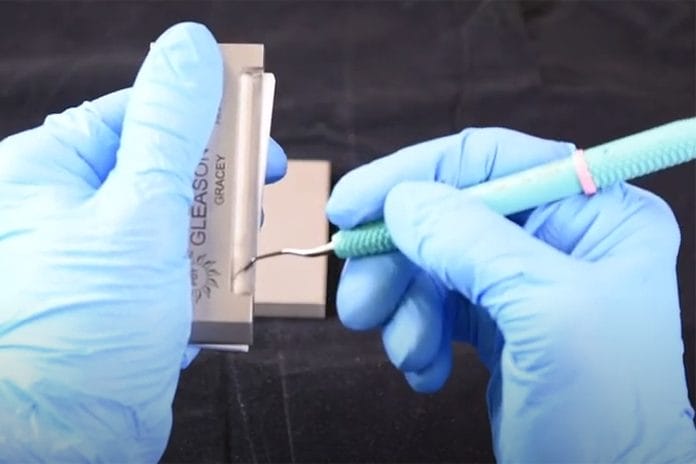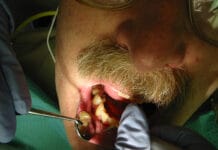Test Your Instrument Sharpening Knowledge
Disclosure: This quiz is sponsored content from PDT Dental as part of our sponsored partner program.
Test your instrument sharpening knowledge and then enter to win a First Line™ Universal Kit, including six instruments in a FlipTop™ cassette, from PDT Dental!
PDT Dental is pleased to introduce their First Line™ Kits designed to be used with your current instruments any time there is a contraindication for power scalers and aerosols. When power scaling isn’t an option, PDT Dental suggests their First Line™ Kits to be used in conjunction with your current kits. These can be the first line for heavy debridement.
Now let's test your instrument sharpening knowledge!
The average number of working strokes that result in a beveled edge is 45.
On average, the number of working strokes that result in a beveled edge is 45. The microhardness of the metal plays a role in the amount of wear after the 45 working strokes; some metals were less beveled than others. Curette toes also exhibited damage even in a well-controlled experiment.
Tal, H., Panno, J.M., Vaidyanathan, T.K. Scanning electron microscope evaluation of wear of dental curettes during standardized root planing. J Periodontol. 1985; 56(9): 532–536. doi:10.1902/jop.1985.56.9.532. Retrieved from https://pubmed.ncbi.nlm.nih.gov/3897505/
What are the benefits of sharp instruments?
A sharp edge grabs the deposit close to the attachment site, requiring less pressure to remove the deposit. Sharp edges help to break deposits off in larger pieces, reducing the risk of leaving smaller pieces behind that are easily burnished. Fewer strokes mean less operating time as well as minimal patient discomfort and less fatigue for the clinician.
Lowe, A. The cutting edge of dental instruments. Vital 7, 33–35 (2010). https://doi.org/10.1038/vital1242. Retrieved from https://www.nature.com/articles/vital1242#citeas
Repeated sharpening and improper sharpening techniques will result in the dimensions of your curettes and scalers being very thin. Ensuring the need for sharpening as well as proper technique will extend the life of your instruments.
Though over-sharpening and improper sharpening can lessen the life of your instruments, sharpening is very important. No matter how skilled a clinician, skill will not compensate for a dull instrument.1
Instrument sharpening can be quite time consuming; however, PDT has created the perfect tool to reduce time spent on sharpening while maintaining a consistent edge every time. The Gleason Glide uses three simple steps, stop, rest, glide. The Gleason Glide is made with a ceramic stone, which is harder and leads to greater longevity of instruments. Not to mention you don’t need oil or water when using it. The Gleason Glide can be used on any brand of instruments; it isn’t exclusive to PDT instruments.2
1. Lowe, A. The cutting edge of dental instruments. Vital 7, 33–35 (2010). https://doi.org/10.1038/vital1242. Retrieved from https://www.nature.com/articles/vital1242#citeas
2. Paradise Dental Technology. Frequently asked questions. Retrieved from https://www.pdtdental.com/faqs/
Which of the following is a major sharpening objective?
These objectives can be hard to meet. This is due to sharpening techniques being hard to master. It takes time and practice to be able to master sharpening techniques that will meet these sharpening objectives. Sharpening should remove a minimal amount of material from the blade. Keep in mind, not all methods and techniques will preserve the original features of the instrument. A magnifying glass, loupes, and a test stick may be helpful to make sure the blade is sharp.
Lowe, A. The cutting edge of dental instruments. Vital 7, 33–35 (2010). https://doi.org/10.1038/vital1242. Retrieved from https://www.nature.com/articles/vital1242#citeas
The quality of the cutting edge of a curette can be defined with three words: fineness, delicacy, and durability.
The fineness of the edge refers to the smoothness. The delicacy refers to the angle which the facial and lateral surfaces approach each other. The durability refers to the hardness of the material used to make the cutting edge.
Balevi, B. Engineering specifics of the periodontal curet's cutting edge [published correction appears in J Periodontol 1996 Sep; 67(9): 951] [published correction appears in J Periodontol. 1996 Sep; 67(9): 951]. J Periodontol. 1996; 67(4): 374–378. doi:10.1902/jop.1996.67.4.374. Retrieved from https://pubmed.ncbi.nlm.nih.gov/8708962/?from_term=The+Cutting+Edge+of+Dental+Instruments&from_pos=8
Repeated sterilization can lead to undesirable changes in the physical properties of instruments. These physical changes include corrosion, temper shifts, and loss of structure.
As with all things, this is highly dependent on the mode of sterilization, packaging for sterilization, the instrument manufacturing process, as well as the instrument material. Sterilization in envelopes can increase the release of acid radicals from the package and exasperate damage to the instruments. Stainless steel instruments show fewer physical changes than carbon steel after multiple sterilization cycles in the autoclave.
Porto, A.N., Borges, Á.H., Semenoff-Segundo, A., et al. Effect of repeated sterilization cycles on the physical properties of scaling instruments: a scanning electron microscopy study. J Int Oral Health. 2015; 7(5): 1–4. Retrieved from https://www.ncbi.nlm.nih.gov/pmc/articles/PMC4441227/
On average, how often should instruments be replaced?
The average lifespan of an instrument is 9 to 18 months. This is contingent on several factors, including number of patients, type of patients (more tenacious calculus wears the instrument more quickly), proper maintenance (timely sharpening and type of sharpening stone), and sterilization methods.1,2
1. Vavrosky, K. 6 Things Hygienists Wish Their Doctor/Boss Knew. Today’s RDH. 2019. Retrieved from https://www.todaysrdh.com/6-things-hygienists-wished-their-doctor-boss-knew/
2. Paradise Dental Technology. Frequently asked questions. Retrieved from https://www.pdtdental.com/faqs/
Which of the following describes why, after significant blade reduction, the instrument needs to be replaced?
After significant reduction, instruments must be retired and discarded. These instruments have a higher chance of breakage from lateral pressure, which may leave pieces in the sulcus. A significantly reduced blade will not adapt properly to the tooth surface rendering the instrument useless in the removal of deposits. When instruments become narrow, but do not have significant reduction, they may be used for patients with minimal deposits that require only biofilm disruption.
Boyd, L.D., Mallonee, L.F., Wyche, C.J., Halaris, J.F. Chapter 38 Instrument Care and Sharpening. Wilkins’ Clinical Practice of the Dental Hygienist. 13th Edition. Retrieved from https://books.google.com/books?id=u729DwAAQBAJ&pg=PA677&lpg=PA677&dq=Sharpening+of+Periodontal+Instruments+With+Different+Sharpening+Stones+and+Its+Influence+Upon+Root+Debridement--Scanning+Electronic+Microscopy+Assessment&source=bl&ots=tn5-6_9kqR&sig=ACfU3U1vgf_3t5XtHAerPSE-jnRbmu_1TQ&hl=en&sa=X&ved=2ahUKEwisvPfn_9voAhWGMd8KHfBtBzAQ6AEwAnoECAsQKw#v=onepage&q=Sharpening%20of%20Periodontal%20Instruments%20With%20Different%20Sharpening%20Stones%20and%20Its%20Influence%20Upon%20Root%20Debridement--Scanning%20Electronic%20Microscopy%20Assessment&f=false












